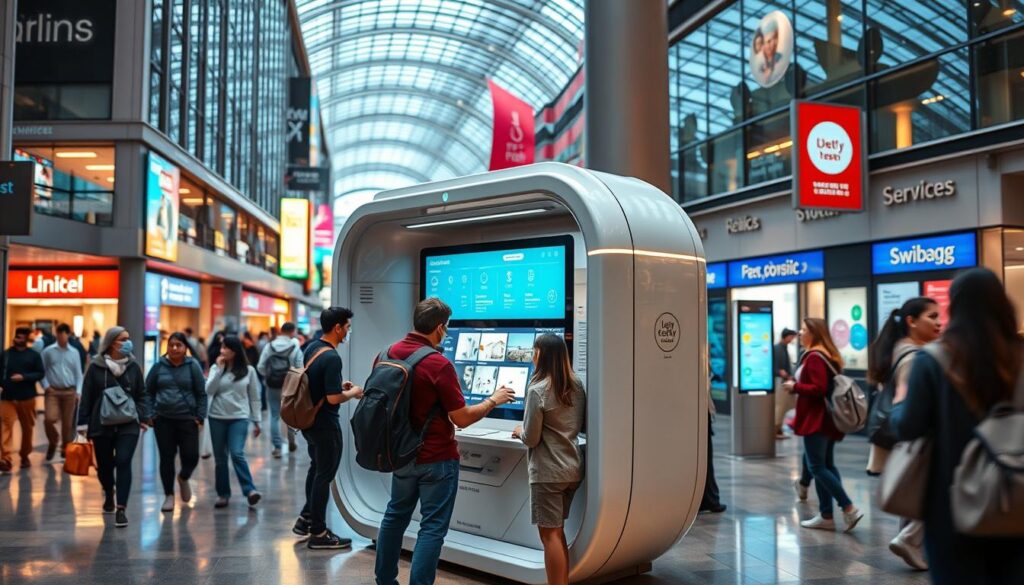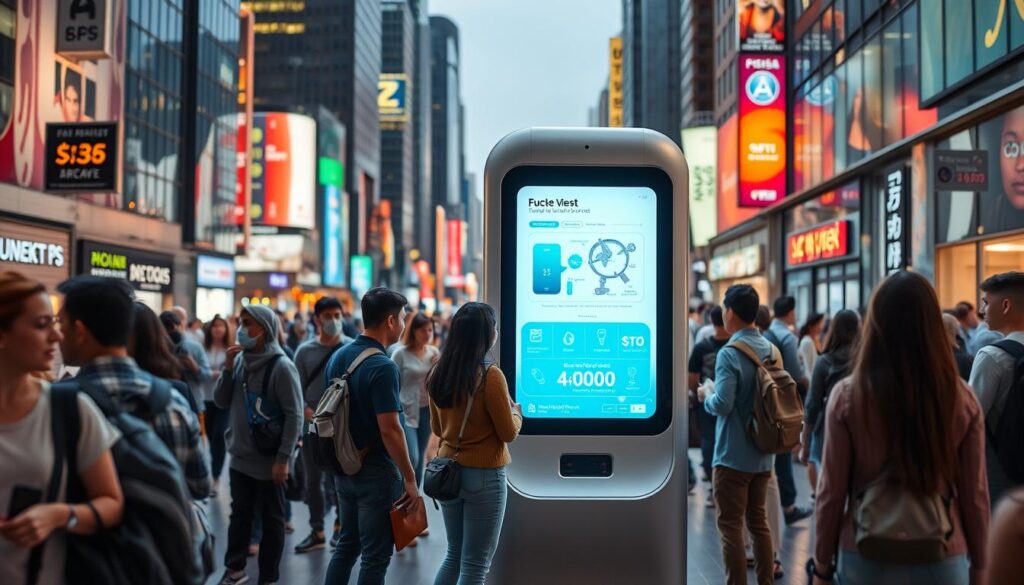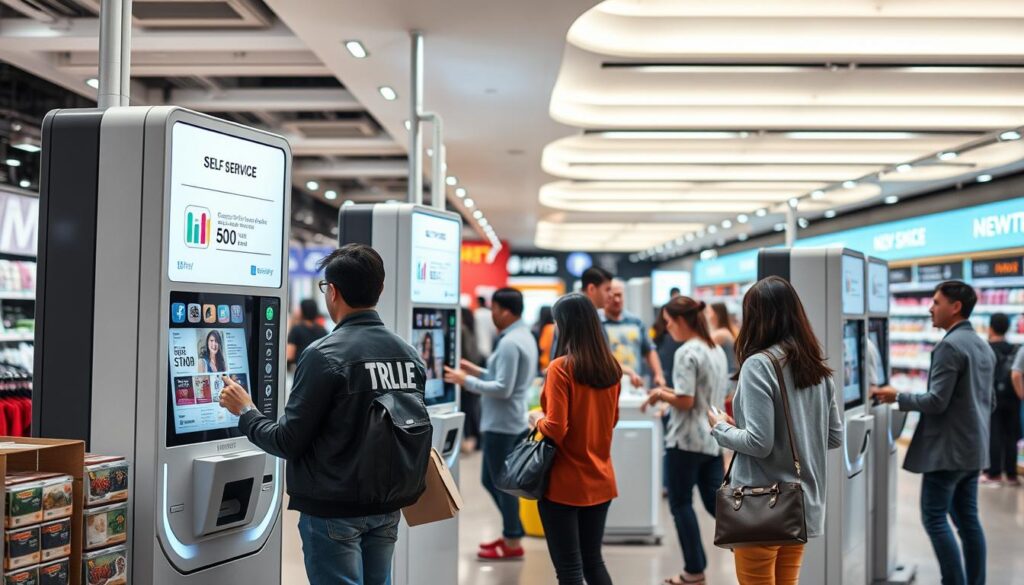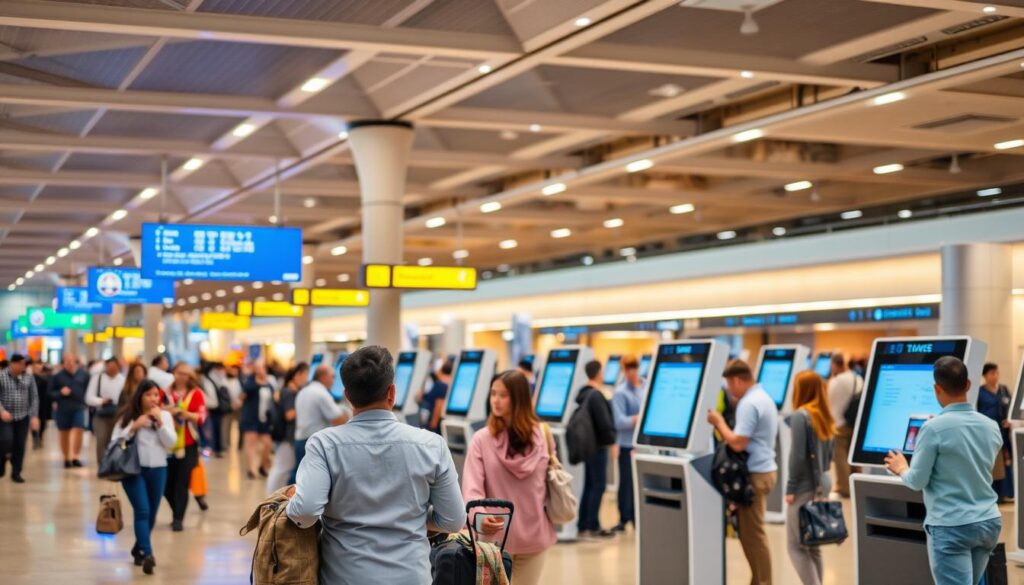In today’s fast world, self-service kiosks are changing the game for businesses. These automated systems let customers do things on their own, without needing help from staff. The global self-service kiosk market was worth $12.05 billion in 2020 and is set to hit $21.42 billion by 2027.
These kiosks bring many benefits. They save time, make things more convenient, and give customers more control. They’re used in retail, banking, hospitality, and healthcare, among other areas.

Key Takeaways
- The self-service kiosk market is expected to nearly double in value from 2020 to 2027, reaching $21.42 billion.
- Over 60% of grocery retailers believe customers will switch merchants if self-service kiosks are not provided.
- Self-service technology can lead to a 30% reduction in labor costs by automating repetitive tasks.
- By 2023, over 75% of organizations are expected to use CIAM to collect data from self-service interactions.
- Kiosks in restaurants can make it easier to upsell, increasing business revenue and profits.
Understanding Self-Service Kiosk Technology
Self-service kiosks are digital platforms that let customers get services and info on their own. They have both hardware and software parts. This includes touchscreen displays, secure cases, and special software for easy use.
Definition and Core Components
At the center of self-service kiosks are touchscreen computers or tablets. These are the main way customers interact. They are in strong, safe cases to protect them and work well.
Other devices like printers, card readers, and barcode scanners are also part of the kiosk. They make the kiosk more useful and easy to use.
Evolution of Self-Service Solutions
The self-service kiosk world has changed a lot in recent years. Old kiosks, costing $10,000 to $20,000, are now replaced by tablet-based ones. These newer kiosks are cheaper, costing under $1,000. This makes them more affordable for businesses of all sizes.
Types of Interactive Kiosks
- Ordering and self-checkout kiosks
- Visitor check-in and registration systems
- Contactless payments and digital signage solutions
- Wayfinding kiosks for navigation and directory services
- Product information and education displays
These kiosks are used in many places. You can find them in transportation hubs, retail stores, healthcare places, and public service centers. They make customer experiences better and help businesses run smoother.
“Self-service kiosks are transforming the way customers engage with businesses, making things more convenient and personalized.”
The Growing Market of Self-Service Technology
The self-service kiosk market is growing fast. This is because people want quick and easy transactions. A survey in June 2022 found that over 60% of grocery stores in the US and UK think customers will go elsewhere if they don’t have kiosks.
This technology is now used in retail, restaurants, airports, and more. It makes things more efficient and improves how customers feel.
The COVID-19 pandemic made kiosks even more popular. They let people order and pay without touching others. This makes transactions more accurate and better for customers. It also makes things faster, reducing wait times and helping businesses make more money.
Using kiosks lets businesses focus on helping customers and selling better products. This can make customers happier and more likely to come back. It also saves money and makes things more efficient, which can help businesses grow.
The market for self-service kiosks is set to grow by 6.4% each year from 2021 to 2026. This is because they save restaurant owners money and make things easier. Kiosks can make orders 30% bigger than usual and encourage people to spend 20% more than they would at a counter.
People like kiosks because they make things easier and more personal. As more businesses use this technology, they can make things better for their customers. This means more money and happier customers for everyone.
| Key Statistic | Benefit |
|---|---|
| Up to 30% increase in average check for orders made via kiosks | Increased revenue and profitability |
| 20% more spending on average compared to traditional counter ordering | Increased average transaction value and revenue |
| 47% of guests use kiosks to customize their orders | Improved customer satisfaction and loyalty |
| 75% of customers desire split bill features | Enhanced convenience and customer experience |
| 69% of customers find long lines frustrating | Reduced wait times and improved customer experience |
“The growing market of self-service technology is transforming the way businesses operate, making things more efficient, improving customer experience, and increasing profits.”
What Are Self-Service Kiosks? An Overview of Their Benefits and Uses
Self-service kiosks are changing how businesses talk to their customers. These interactive machines let customers do things like order and pay for things on their own. They also help customers get information and finish their transactions. It’s important to know how these tools help different industries.
Key Features and Functionalities
Self-service kiosks have easy-to-use touch screens. Customers can pick what they want and pay with cards or mobile wallets. They can also get personalized tips based on what they like.
Common Applications Across Industries
- Retail: Self-checkout kiosks for faster and more convenient shopping experiences
- Restaurants: Ordering and payment kiosks to streamline the ordering process and reduce wait times
- Hospitality: Check-in and check-out kiosks to expedite hotel and airline check-in/out procedures
- Public Spaces: Informational kiosks to provide access to maps, schedules, and other community resources
- Healthcare: Self-service kiosks for patient check-in, appointment scheduling, and accessing medical records
Hardware and Software Integration
Self-service kiosks work best when hardware and software are well matched. Businesses can pick and choose what they need. The hardware, like screens and payment machines, should work smoothly. The software should be easy to use and fit with the business’s systems.

| Metric | Value |
|---|---|
| Global Sales of Interactive Kiosks (2021) | $12.1 billion |
| Global Sales of Interactive Kiosks (2020) | $10.6 billion |
| Customers Who Would Visit a Restaurant More Often with Self-Service Kiosks | 65% |
| Customers Who Prefer Kiosk Ordering Over Cashier | 30% |
| Retail Customers Who Use Self-Checkout Due to Speed | 49.4% |
| Consumers Who Prefer Self-Service Over Interacting with Employees | 66% |
| Increase in Perceived Food Quality from Visual Appeal on Kiosks | 29% |
Cost-Effectiveness and ROI for Businesses
Self-service kiosks are changing the game for businesses in many fields. They offer a cost-effective way to make operations more efficient. Forrester research shows they can cut labor costs by up to 30%. This makes them a great choice for retail automation and restaurant ordering systems.
These kiosks automate routine tasks and reduce the need for sales staff. This boosts productivity and helps handle lots of transactions. It’s a big win for small businesses, letting them compete with big chains by improving service and efficiency.
The global interactive kiosk market is projected to reach a value of $21.42 billion by 2027. This shows the growing need for this technology. Self-service kiosks offer high automation, cutting down on costs and leading to a big return on investment (ROI).
In the restaurant world, the average ROI for Quick Service Restaurants (QSRs) in 2022 was about 5%. But, using self-service kiosks can boost this by up to 30%. This is thanks to higher order values and shorter wait times.
“Customers are 61% likely to use kiosks for ordering according to the National Restaurant Association’s 2022 State of the Restaurant Industry report.”
Self-service kiosks also ensure consistent service at any time. This boosts customer satisfaction and loyalty. This can lead to more profits and a strong market position.
In summary, the cost savings and ROI from self-service kiosks make them a smart choice. They help businesses streamline, improve productivity, and give customers a better experience.

Enhanced Customer Experience and Satisfaction
Self-service kiosks have changed how businesses talk to customers. They make the experience better and happier. By cutting down wait times, these kiosks let customers handle their own business, saving them time.
These kiosks also offer personal touches. Businesses use the data from kiosks to give special deals and a custom experience. This makes customers happier and more likely to come back.
24/7 Service Availability
Self-service kiosks work all day, every day. This is great for places like hotels and shops. Guests and customers can get what they need whenever they want.
Contactless Payments and Hygiene
With COVID-19, kiosks with no-touch payments are more popular. They let customers pay safely with phones or cards. This makes shopping and services safer and cleaner.
| Industry | Self-Service Kiosk Applications | Key Benefits |
|---|---|---|
| Hospitality | Check-in/check-out, room service ordering, concierge services | Reduced wait times, 24/7 availability, personalized recommendations |
| Retail | Product information, self-checkout, order pickup | Improved customer engagement, increased sales, streamlined operations |
| Food Service | Ordering, payment, loyalty program management | Faster service, order accuracy, personalized offers |
| Healthcare | Check-in, appointment scheduling, prescription refills | Convenient access, reduced administrative workload, improved patient experience |

“Self-service kiosks have transformed the way our customers interact with our brand. By providing a personalized and efficient experience, we’ve seen a significant increase in customer satisfaction and loyalty.”
– John Doe, Retail Manager
Implementation Strategies for Different Industries
Self-service kiosks are changing the game in many industries. They improve customer experiences and make operations more efficient. These kiosks are used in retail, restaurants, and for employee services, showing their wide range of uses.
In retail, self-checkout kiosks cut down on long lines and boost efficiency. They let customers pay quickly, freeing staff to do more important work. A big win for retailers, as 67% of customers like using these kiosks.
Restaurants use self-ordering kiosks to make orders more accurate and increase sales. Customers can customize their meals and pay easily. This can raise sales by 15-20% and make dining faster and more enjoyable.
In hospitality, self-check-in kiosks are key for a smooth guest experience. Guests can check in, see their room details, and request services without staff help. This makes guests happier and staff more available for personal service.
Healthcare also uses self-service kiosks for patient registration. This makes check-in faster, reduces paperwork, and helps staff focus on more important tasks. It’s a win for both patients and healthcare providers.
For self-service kiosks to work well, they need to fit the specific needs of each industry. By understanding what each sector needs, businesses can use these kiosks to improve operations and customer satisfaction. This gives them a competitive edge.
| Industry | Self-Service Kiosk Applications | Key Benefits |
|---|---|---|
| Retail | Self-checkout, product information, order pickup | Reduced wait times, improved efficiency, enhanced customer experience |
| Restaurants | Self-ordering, customization, payment processing | Increased order accuracy, higher average order value, faster service |
| Hospitality | Self-check-in, service requests, information access | Streamlined guest experience, enhanced operational efficiency |
| Healthcare | Patient registration, appointment scheduling, information access | Reduced paperwork, improved patient flow, efficient resource allocation |
By using self-service kiosks, businesses in different fields can gain many benefits. These include better customer experiences, more efficient operations, and higher profits. As more businesses look to self-service technology, the chance to improve customer service is greater than ever.
Technology Integration and Security Considerations
Self-service kiosks are becoming more common in many industries. It’s important to use the latest technology and strong security. Keeping customer data safe and making transactions smooth and secure is key for businesses.
Data Protection Measures
Following data privacy laws, like GDPR, is a must for kiosks. Companies need to protect data with encryption, access controls, and backups. This ensures customer info stays safe and accurate.
Payment Processing Security
Secure payment is a big deal for kiosks in places like healthcare and retail. Following PCI DSS rules helps fight fraud and keeps transactions safe. Adding contactless payments, like mobile wallets, makes things easier and safer for users.
System Maintenance Requirements
Keeping kiosks running smoothly is essential. This includes updates, hardware checks, and watching how they perform. Working with kiosk vendors to create a maintenance plan is important. It keeps everything working well and keeps customers happy.
FAQ
What are self-service kiosks?
Self-service kiosks are automated systems that let customers do things on their own. They use touchscreens and special software. This makes things easier and faster for everyone.
What are the key features and functionalities of self-service kiosks?
These kiosks have touchscreens, can process payments, and show information. They also connect with business systems and databases. They help with ordering, self-checkout, and more in public places.
How is the self-service kiosk market growing?
The market was worth $12.05 billion in 2020 and is expected to hit $21.42 billion by 2027. It’s growing fast in retail, restaurants, airports, and more. This is because it makes things more efficient and better for customers.
What are the common applications of self-service kiosks across different industries?
They’re used for ordering and self-checkout in stores and restaurants. They help with check-in at hotels and airports. They also provide information in public areas. Each industry uses them in ways that fit their needs and what customers want.
How do self-service kiosks improve cost-effectiveness and ROI for businesses?
Forrester says they can cut labor costs by up to 30%. They make things run smoother and are cheaper for businesses. They’re great for handling lots of transactions without needing lots of staff.
How do self-service kiosks enhance customer experience and satisfaction?
They make things faster and offer personalized experiences. They’re available 24/7. This gives customers more control and helps businesses learn more about their customers.
What are the key technology integration and security considerations for self-service kiosks?
Security is very important. Data protection and payment security must meet standards. Regular updates and checks are needed to keep everything running well and safely.